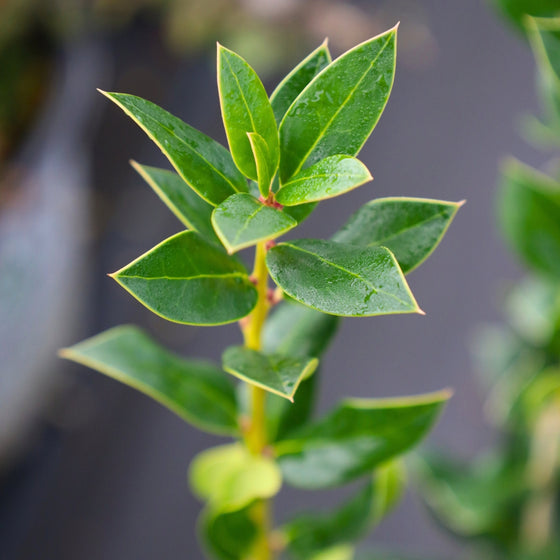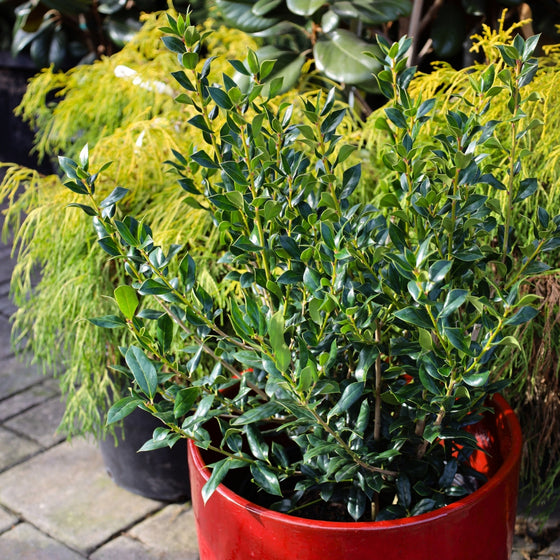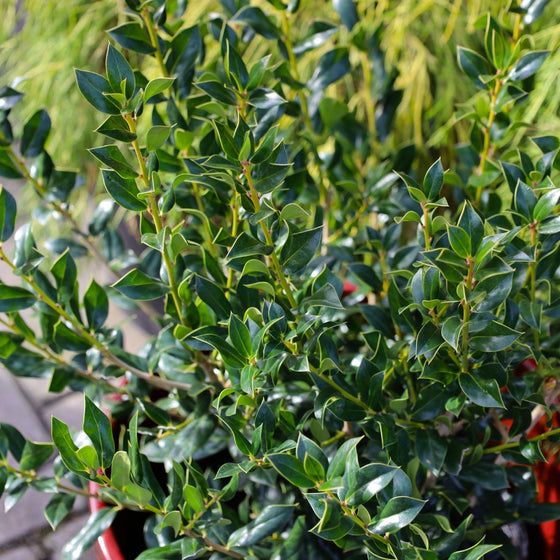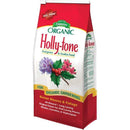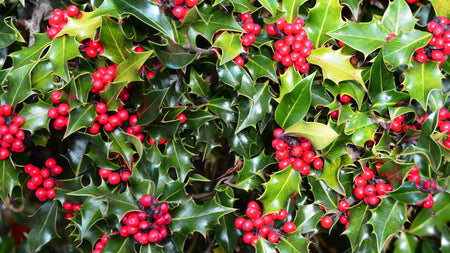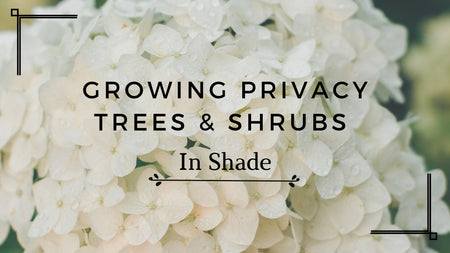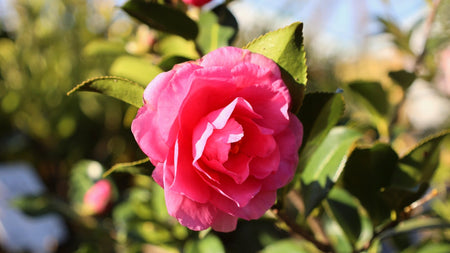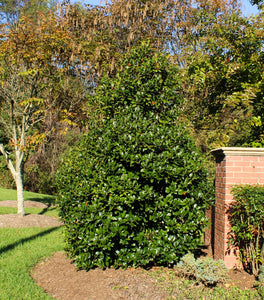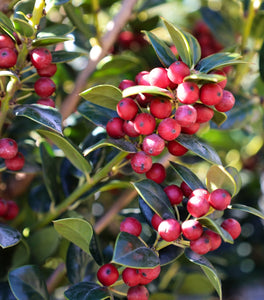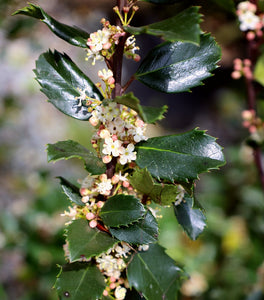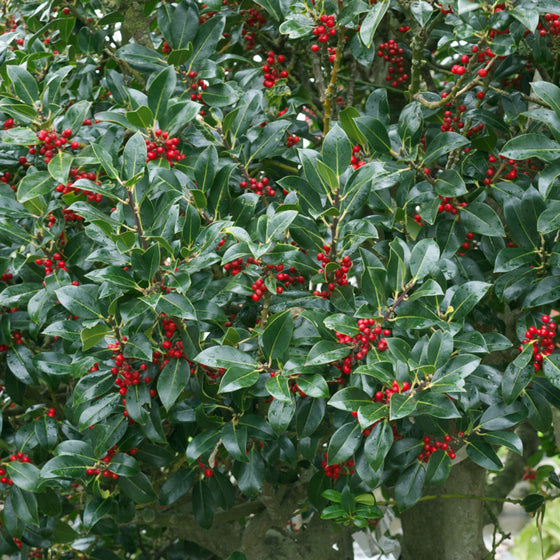
Images Depict Mature Plants
Needlepoint Holly Shrubs for Sale Online
Needlepoint Holly (Ilex cornuta 'Needlepoint') is a striking evergreen shrub known for its glossy, elongated leaves and abundant bright red berries that persist well into winter. The distinctive leaves of Needlepoint Holly have a single spine, giving them a unique, attractive appearance compared to other hollies with more spiny leaves. Reaching a mature height of 10 to 15 feet with a spread of 8 to 10 feet, this holly is perfect for creating tall hedges, privacy screens, or as a focal point in mixed borders. Its dense, upright growth habit provides a year-round structure, while its colorful berries add vibrant winter interest, making Needlepoint Holly a popular choice for many landscaping needs.
Needlepoint Holly thrives in full sun to partial shade and is adaptable to various soil types, including clay, provided the soil is well-drained. This hardy shrub is also drought-tolerant once established, making it an ideal choice for low-maintenance gardens in a range of climates. Needlepoint Holly is deer-resistant, which appeals to those in areas with frequent deer activity. Its attractive red berries, which appear in late fall and last through winter, bring seasonal color to the landscape and attract birds, providing an important food source when other options are scarce. To produce these vibrant berries, Needlepoint Holly requires a nearby male pollinator, such as Dwarf Burford Holly or China Boy Holly, for successful fertilization.
Versatile and easy to maintain, Needlepoint Holly is suitable for various landscaping applications, from hedges and screens to foundation plantings and specimen shrubs. Its dense foliage also makes it an excellent choice for creating a natural windbreak or privacy barrier. At the same time, the narrow, pointed leaves offer a unique texture that contrasts beautifully with other garden plants. With its combination of glossy, evergreen foliage, eye-catching red berries, and low-maintenance needs, Needlepoint Holly is an excellent choice for anyone looking to add year-round beauty and ecological value to their garden.
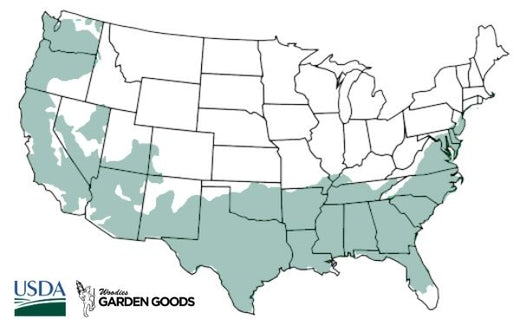
| Hardiness Zone: | 7-9 |
|---|---|
| Mature Height: | 15 to 20 Feet |
| Mature Width: | 10 to 16 Feet |
| Sunlight: | Full sun to part shade |
| Foliage Color: | Dark green |
| Growth Form: | Dense Upright pyramidal |
| Soil Conditions: | Very tolerant of most soil conditions |
How to Care for Needlepoint Holly
Once you buy a Needlepoint Holly, make sure to read about the care instructions that are recommended to keep your Holly healthy and thriving.
How do I plant a Needlepoint Holly?
To plant a Needlepoint Holly, start by selecting a location that offers full sun to partial shade and well-drained soil. This hardy evergreen shrub is adaptable to various soil types, including clay, but prefers slightly acidic, fertile conditions for optimal growth. Begin by digging a hole that is twice as wide and about the same depth as the root ball. This allows ample space for the roots to spread and establish. Place the Needlepoint Holly in the hole, making sure that the top of the root ball is level with the surrounding soil. Backfill with the original soil, gently tamping it down to eliminate any air pockets, and then water thoroughly to help the plant settle in. Consistent watering during the initial planting stage is crucial to promote a healthy root system. After planting your Needlepoint Holly, apply a 2-3 inch layer of organic mulch around the base to retain moisture, regulate soil temperature, and prevent weeds from competing for nutrients. Be sure to keep the mulch a few inches away from the trunk to avoid rot. If you plan to use Needlepoint Holly for a hedge or screen, space the shrubs 5 to 8 feet apart to allow for proper growth while ensuring a dense barrier as they mature. Regular watering is important during the first growing season, especially during dry periods, to help establish a strong root system. For successful berry production, make sure to plant a compatible male holly nearby, such as Dwarf Burford Holly or China Boy Holly, for pollination. With the right planting technique and care, Needlepoint Holly will thrive, providing year-round lush foliage and vibrant red berries.
How often do I water my Needlepoint Holly?
To properly water a Needlepoint Holly, it's important to maintain consistent moisture, especially during the first year of planting to help the shrub establish a strong root system. Water deeply once or twice a week, depending on rainfall and soil conditions, to ensure the root zone remains adequately hydrated. A slow, thorough watering technique, such as using a soaker hose, is ideal for allowing water to penetrate deep into the soil, encouraging healthy root growth. During the hot summer months, it may be necessary to water more frequently to prevent the soil from drying out completely. However, avoid waterlogging the roots, as Needlepoint Holly prefers well-drained soil that is moist but not overly wet. Once your Needlepoint Holly is established, it becomes more tolerant of occasional dry spells but will still benefit from regular watering during prolonged periods of heat or drought. To help retain soil moisture and reduce the need for frequent watering, apply a 2-3 inch layer of organic mulch around the base of the shrub. This mulch will also help regulate soil temperature, keeping roots cool during hot weather and minimizing evaporation. Make sure to keep the mulch a few inches away from the trunk to prevent rot and allow air circulation. With proper watering practices, your Needlepoint Holly will grow into a lush, healthy shrub, providing glossy foliage and vibrant red berries that enhance your landscape year-round.
How do I fertilize a Needlepoint Holly?
To fertilize a Needlepoint Holly, apply a balanced, slow-release fertilizer, such as 10-10-10, in early spring just before new growth begins. This will provide the nutrients needed for lush, healthy foliage and robust berry production throughout the year. Spread the fertilizer evenly around the base of the shrub, extending to the drip line, which is the area beneath the outer branches where the roots actively absorb nutrients. Avoid applying fertilizer directly against the trunk, as this can cause root burn. After fertilizing, water thoroughly to help the nutrients reach the roots and become absorbed effectively. A well-fertilized Needlepoint Holly will maintain its vibrant, deep green leaves and produce an abundance of bright red berries. In addition to chemical fertilizers, Needlepoint Holly benefits from the use of organic matter, such as compost or well-rotted manure, which can be mixed into the soil to improve its structure and provide a slow, consistent release of nutrients. It is also beneficial to test your soil to determine the pH level, as holly shrubs thrive in slightly acidic soils with a pH between 5.0 and 6.5. If the soil is too alkaline, adding Espoma Soil Acidifier can help lower the pH and create a more favorable environment for nutrient uptake. Avoid over-fertilizing, as this can lead to excessive vegetative growth and a reduction in berry production. By providing the right nutrients, you will ensure that your Needlepoint Holly remains healthy, resilient, and capable of producing the vibrant berries that attract wildlife and add beauty to your garden.

How do I Prune Needlepoint Holly?
To prune a Needlepoint Holly, it is best to do so in late winter or early spring before new growth starts. This timing ensures that the shrub is pruned when it is dormant, which encourages healthy new growth during the growing season. Begin by removing any dead, damaged, or diseased branches, which will help maintain the plant's overall health and reduce the risk of pests and diseases. Next, thin out the interior branches to improve air circulation and light penetration, which helps to reduce the risk of fungal issues and encourages a dense growth habit. Use clean, sharp pruning shears to make clean cuts, promoting faster healing and minimizing stress on the plant. For Needlepoint Holly grown as a hedge or a formal screen, light pruning throughout the growing season is recommended to maintain its desired shape and size. This holly has a naturally dense growth habit, so regular pruning will help keep it looking tidy and ensure it retains its attractive form. Be careful not to over-prune, as removing too much foliage can reduce berry production and limit the shrub's ability to provide food for birds in the winter. If your Needlepoint Holly is grown as an individual specimen, you can allow it to take on a more natural shape, pruning only as needed to control its size or remove unwanted growth. By properly pruning your Needlepoint Holly, you will maintain its dense, attractive appearance and enjoy glossy foliage and vibrant berries year-round.

